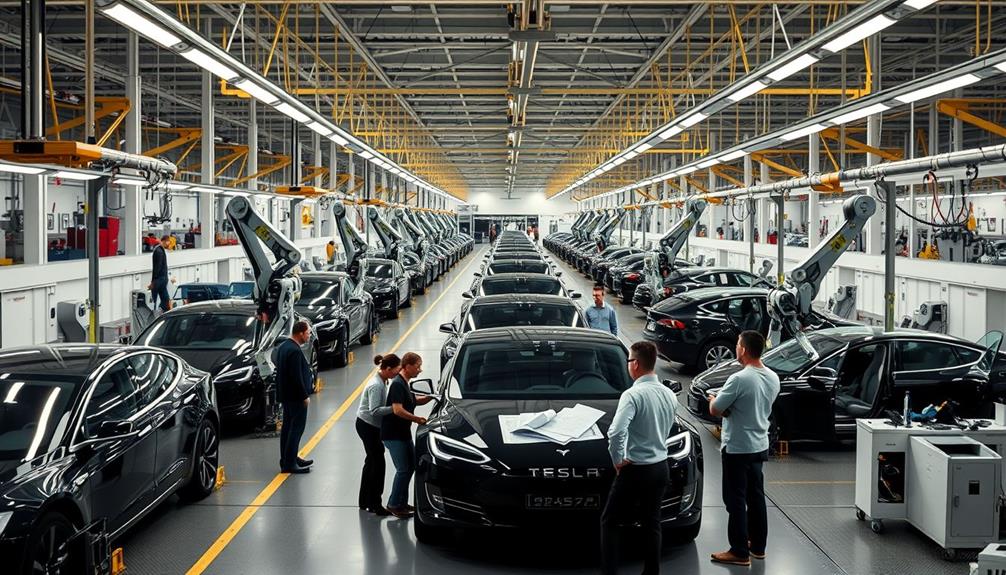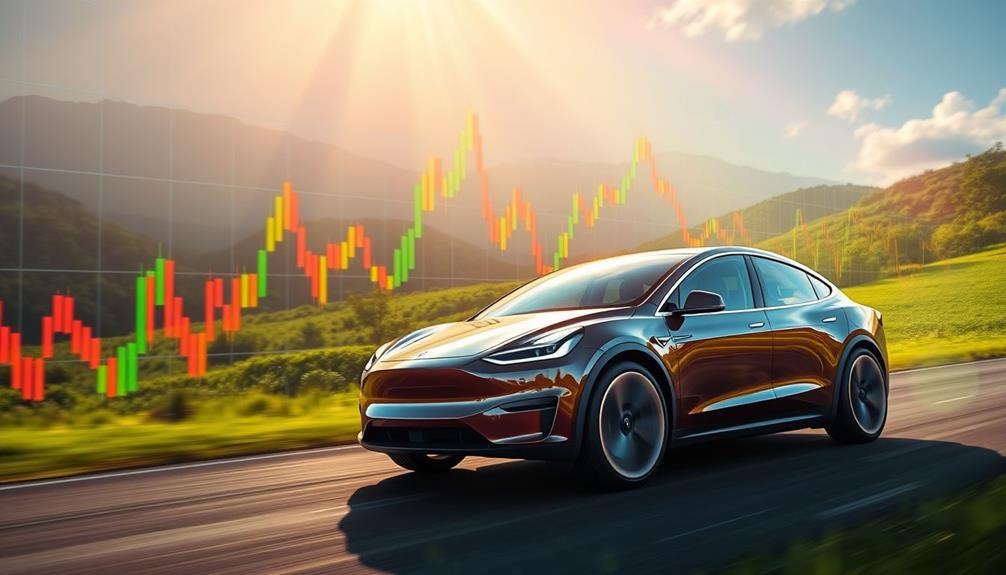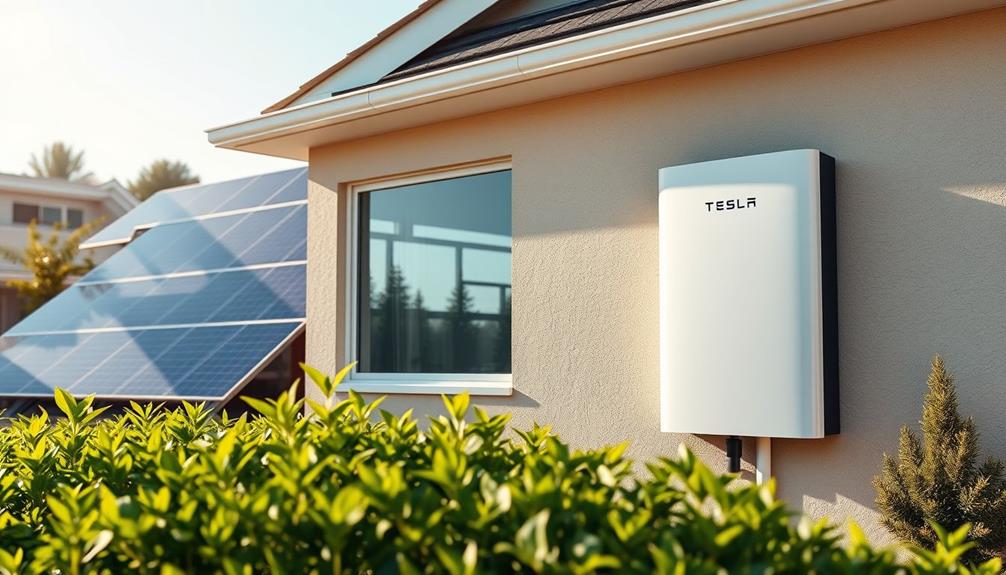Tesla's stock has stumbled lately, dropping 12% year-to-date and facing a 43% decline in earnings per share. However, analysts are cautiously optimistic. They've projected a 17.8% revenue increase by 2025 and long-term growth between 20%-40%. The much-anticipated robotaxi rollout could markedly boost Tesla's value, despite the recent delay. Analysts like Morgan Stanley see a 40% upside potential, and Ark Invest forecasts a bold price target of $2,600 by 2029. While challenges persist, there's a pathway for recovery. Keep an eye on future developments to see how this unfolds and what it means for your investment.
Key Takeaways
- Analysts project a recovery in Tesla's earnings per share to $3.39 by 2025, indicating potential for stock price improvement post-2024 dip.
- Morgan Stanley identifies Tesla as a top pick with a significant 40% upside potential, reflecting optimism among some market analysts.
- The anticipated launch of the Robotaxi network could substantially increase Tesla's enterprise value, with Ark Invest projecting a price target of $2,600 by 2029.
- Despite current challenges, Tesla's energy storage business is expected to outpace automotive growth, contributing positively to overall revenue.
- Regulatory hurdles and compliance challenges, particularly in Europe, may hinder Tesla's market position and impact short-term stock performance.
Current Stock Performance

As of now, Tesla stock's performance has been marked by significant volatility. Year-to-date, you've seen a 12% decline, and since its July 2024 highs, it's dropped by 20%. This reflects the negative market sentiment surrounding the company.
After the Q2 earnings report revealed a staggering 43% drop in earnings per share (EPS), Tesla's stock fell by 7.7% in August, which understandably raised concerns.
Analysts are projecting a decline in EPS for 2024, estimating it at $2.24, down 28% from 2023's $3.12. This forecast adds to the uncertainty about Tesla's future. Currently, Tesla ranks third in the IBD Auto Manufacturers industry group, holding a Composite Rating of 67, which indicates it still has potential, but challenges remain.
Despite recent struggles, there's been a silver lining; Tesla stock has rebounded 60% from late-April lows. This recovery hints at resilience under favorable market conditions.
For investors keeping an eye on Tesla, understanding these dynamics is essential—it could determine whether you're looking at a company poised for recovery or one that's still facing uphill challenges.
Robotaxi Launch Insights

You might've noticed that Tesla's Robotaxi reveal has been pushed back to October 10, 2024, as the company focuses on design improvements.
With Elon Musk committing $10 billion to AI training and infrastructure, the ride-hailing service is set to enhance its functionality considerably.
This delay and investment could have lasting effects on Tesla's stock value, especially as the Robotaxi business is projected to drive a major portion of the company's future enterprise value.
Unveiling Delays Explained
While the revelation of Tesla's much-anticipated Robotaxi has been delayed until October 10, 2024, there's a clear rationale behind this decision: the company aims to enhance the design before its launch. Elon Musk is investing a staggering $10 billion in AI training and infrastructure this year, ensuring the Robotaxi service meets high expectations.
The significance of this initiative can't be understated. Ark Invest forecasts that by 2029, the Robotaxi business could represent 90% of Tesla's enterprise value, with a price target of $2,600 per share if successful. In contrast, without the Robotaxi network, the stock price could plummet to $350, emphasizing the urgency of these delays.
| Key Factors | Impact on Tesla | Future Outlook |
|---|---|---|
| Robotaxi Launch | Critical to value | Strong potential |
| AI Investments | Enhances service | Long-term growth |
| Ark Invest Projections | Bullish sentiment | Encouraging trends |
Experts remain optimistic about the service's launch within five years, reinforcing a strong long-term outlook for Tesla's autonomy initiatives. With these strategic enhancements, you can expect a more robust Robotaxi when it finally reveals.
Financial Investment in AI
Investing heavily in AI is a cornerstone of Tesla's strategy to enhance its upcoming robotaxi service. Elon Musk has committed $10 billion for AI training and inference in 2024, focusing on improving Tesla's AI infrastructure. This investment aims to boost the functionality of the robotaxi service, which Ark Invest believes could greatly impact Tesla stock.
They project a price target of $2,600 for TSLA by 2029, with 90% of the company's enterprise value tied to the anticipated success of the robotaxi business.
Though the revelation of the robotaxi has been postponed to October 10, 2024, Tesla is dedicated to refining the vehicle design before launch. This commitment suggests a long-term bullish outlook on Tesla's autonomy initiatives.
Analysts are confident that the financial investment in AI will yield considerable returns, potentially generating an estimated $10 billion annually from the robotaxi model. Such revenue could play an essential role in Tesla's operating income growth.
As Tesla continues to innovate and refine its offerings, the future looks promising for both the robotaxi service and Tesla stock.
Future Impact on TSLA
The anticipation surrounding Tesla's robotaxi launch is palpable, especially after the revelation was postponed to October 10, 2024, to refine the vehicle design. This delay has heightened interest in how the robotaxi introduction will shape Tesla's future.
Ark Invest predicts that by 2029, a staggering 90% of Tesla's enterprise value will be tied to the robotaxi business, with a price target soaring to $2,600 per share if the network launches successfully.
Tesla's commitment to its autonomy initiatives is evident, backed by a significant $10 billion investment for AI training and infrastructure in 2024. This investment aims to enhance the ride-hailing service's functionality, positioning Tesla as a leader in the autonomous vehicle market.
Analysts are optimistic, suggesting that the robotaxi service could be operational within five years, indicating a long-term bullish outlook.
However, the stakes are high. If the robotaxi network fails to materialize, Ark Invest warns that Tesla's stock price could plummet to as low as $350 per share, underscoring the critical impact this project has on Tesla's overall valuation.
Your investment decisions will hinge on the success of this ambitious endeavor.
Vehicle Production Plans

Tesla's vehicle production plans are evolving as the company navigates a shifting market landscape. You might've heard about Tesla's intention to mass-produce an affordable vehicle in the first half of 2025, although there are whispers about potentially scrapping the $25,000 Model 2.
It's important to highlight that while vehicle volume growth for 2024 is expected to decline, delivery estimates for Q3 still project 458,000 units, marking a 5% year-over-year increase.
As Tesla shifts resources away from the automotive segment due to changing demand, this impacts their overall vehicle production strategies. Notably, their energy storage business is set to grow faster than the automotive sector, suggesting a strategic pivot.
This diversification might be vital to staying competitive in an increasingly crowded market.
Despite these challenges, the anticipated launch of new vehicle models aligns with Tesla's goal to maintain its leadership position in the electric vehicle space.
Regulatory Hurdles

As you consider Tesla's stock outlook, it's essential to recognize the impact of regulatory hurdles.
The additional tariffs from the E.U. and ongoing investigations into vehicle safety could greatly affect pricing and investor confidence.
Steering through these challenges will be key to Tesla’s competitive edge and overall market performance. In order to maintain its competitive edge, Tesla must also leverage its innovative technology and continue to expand its product offerings. Additionally, the company can capitalize on its Tesla Premium Connectivity benefits, such as advanced navigation, media streaming, and over-the-air software updates, to attract and retain customers. By focusing on these areas, Tesla can stay at the forefront of the electric vehicle market and continue to drive growth and success.
Tariff Impacts Overview
Tariffs on Tesla vehicles imported from China present significant regulatory hurdles that could hinder the company's growth in Europe.
With the E.U. imposing an additional 9% tariff on these vehicles, alongside the existing 10% tariff on foreign-made cars, the cumulative tariff impacts could severely affect the pricing and sales of models like the Model 3 and Model Y.
This scenario creates a competitive disadvantage when compared to local manufacturers who face lower tariffs.
Moreover, additional tariffs of up to 38.1% on vehicles exported to Europe from other Chinese EV manufacturers further complicate Tesla's situation.
As you consider investing, it's important to highlight that ongoing regulatory compliance issues, such as the NHTSA recall of over 2 million vehicles due to Autopilot misuse, could further erode consumer trust.
The long-standing investigations into faulty suspension and steering parts also cast a shadow over Tesla's reputation.
In this complex landscape of tariffs and regulatory challenges, understanding how these factors play into Tesla's future performance will be essential for your investment decisions.
Ongoing Investigations Summary
Regulatory hurdles continue to pose challenges for the electric vehicle market, particularly for Tesla. Ongoing investigations by the NHTSA into Autopilot misuse have already triggered an over-the-air recall affecting over 2 million vehicles. Additionally, scrutiny from Norway and Sweden regarding faulty suspension and steering parts has persisted for over seven years.
| Investigation | Impact on Tesla | Duration |
|---|---|---|
| NHTSA Autopilot | Over-the-air recall | Ongoing |
| Faulty Parts | Increased scrutiny | 7+ years |
| EU Tariffs | Pricing strategy hit | Recently imposed |
Furthermore, the EU's new 9% tariff on Tesla vehicles from China, along with a 10% tariff on all foreign-made cars, complicates its competitive landscape. Reports suggest additional tariffs of up to 38.1% on other Chinese EV models, threatening Tesla's market position. These factors contribute to declining vehicle deliveries and may negatively impact investor sentiment regarding Tesla's performance. The combination of these investigations and tariffs creates a challenging environment for the company as it navigates these regulatory hurdles.
Regulatory Compliance Challenges
Maneuvering the complex landscape of compliance can feel overwhelming for Tesla, especially with ongoing investigations and new tariffs threatening its market position.
The company faces scrutiny from the National Highway Traffic Safety Administration (NHTSA), which has recalled over 2 million vehicles due to Autopilot misuse concerns. This not only impacts vehicle safety but also raises questions about the adequacy of Tesla's over-the-air updates.
In Europe, an additional 9% import tariff on vehicles from China adds to Tesla's existing challenges, potentially affecting pricing and sales in a vital market.
Ongoing investigations in Norway and Sweden into the Model S and X regarding suspension failures further complicate the regulatory compliance landscape.
These issues can negatively influence public perception, shaking investor confidence and complicating operational stability.
With market dynamics shifting and more scrutiny from regulators, Tesla's competitive edge against other electric vehicle manufacturers may be at risk.
As they navigate these regulatory hurdles, Tesla must focus on addressing these challenges to maintain their market position and guarantee the safety and satisfaction of their customers.
Market Analysts' Opinions

Analyzing market analysts' opinions reveals a complex outlook for Tesla's stock. While some analysts are optimistic, others express concerns about earnings per share and revenue growth. Here's what you should consider:
- Earnings Decline: Analysts project a 28% decline in Tesla's earnings per share in 2024, potentially affecting TSLA stock performance.
- Top Pick: Morgan Stanley has named Tesla as the top pick in the U.S. auto sector, citing a 40% upside based on its market leadership in electric vehicles.
- Long-Term Price Target: Ark Invest suggests a bold price target of $2,600 for TSLA by 2029, contingent on the success of its robotaxi business, which could drive significant enterprise value.
- Mixed Recommendations: The average target price for TSLA stands at $182.96, with 17 out of 53 analysts recommending a buy, illustrating a mixed outlook among market watchers.
As you weigh your options to buy or sell Tesla, keep these insights in mind. The interplay between current challenges and future growth opportunities will be vital in determining TSLA's trajectory.
Financial Projections

As you consider the mixed opinions from market analysts, it's important to look at Tesla's financial projections to gauge the company's future performance. Analysts project a significant decline in Tesla's earnings per share (EPS), estimating it to be $2.24 in 2024, which is a 28% drop from last year's $3.12. This decline raises questions about the company's ability to bounce back.
Below is a snapshot of Tesla's key financial metrics:
| Metric | 2023 | 2024 (Projected) | 2025 (Projected) |
|---|---|---|---|
| Earnings Per Share | $3.12 | $2.24 | – |
| Revenue Growth | – | – | $115.7 billion |
| Operating Margin | 9.2% | – | – |
| Free Cash Flow | $4.4 billion | – | – |
| Long-Term Growth | 20%-40% | – | – |
Tesla's revenue is expected to grow to $115.7 billion by 2025, reflecting a 17.8% year-over-year increase. However, with operating margins shrinking and free cash flow declining, the company faces profitability challenges that could impact its long-term growth potential.
Long-Term Growth Potential

Tesla's long-term growth potential looks promising, especially as it navigates recent challenges.
With a projected earnings per share of $3.39 for 2025, it's clear that the company is on a recovery path following a dip in 2024. Analysts forecast a revenue of $115.7 billion in 2025, marking a 17.8% increase from the previous year, largely fueled by growth in energy generation and storage.
Here are four key factors supporting Tesla's long-term growth:
- Robotaxi Network: Ark Invest estimates that 90% of Tesla's enterprise value could hinge on the success of this network by 2029.
- Energy Storage: Deployments more than doubled in 2023, showcasing significant growth potential beyond just vehicles.
- Affordable Vehicle Production: The anticipated launch of an affordable vehicle by late 2025 could enhance Tesla's market position.
- Diverse Revenue Streams: Expanding interests in energy storage and other sectors help mitigate risks tied to automotive sales.
With these developments, Tesla stock could see substantial benefits as the company strengthens its market position and explores new avenues for revenue.
Frequently Asked Questions
Is Tesla Stock Expected to Recover?
Tesla stock's expected recovery hinges on upcoming developments like new vehicle production and the robotaxi rollout. While challenges loom, positive news could shift investor sentiment, potentially leading to a rebound in share prices.
Will Tesla Rebound in 2024?
Tesla's projected delivery of 458,000 vehicles in Q3 2024 signals a potential rebound in demand. With mixed analyst sentiments, you should watch for key developments, especially the Robotaxi reveal, which could influence your investment decisions.
What Are Analysts Saying About Tesla Stock?
Analysts are mixed on Tesla stock, with some projecting declines in earnings while others see potential upside. Many recommend buying, citing optimism about future innovations like robotaxis, despite concerns over recent performance fluctuations.
What Is the 5 Year Prediction for Tesla Stock?
In the next five years, you could see Tesla's stock surge towards $2,600 if the robotaxi business succeeds. However, without it, prices might plummet to around $350, emphasizing the importance of this initiative.
Conclusion
To sum up, while Tesla's stock has faced challenges, it's still a compelling player in the market. Did you know that nearly 1 in 5 new cars sold in the U.S. in 2022 were electric? This growing demand for EVs, combined with Tesla's ambitious production goals and potential robotaxi innovations, suggests that the company could rebound strongly. Keeping an eye on regulatory changes and market trends will be key to understanding Tesla's future trajectory.










